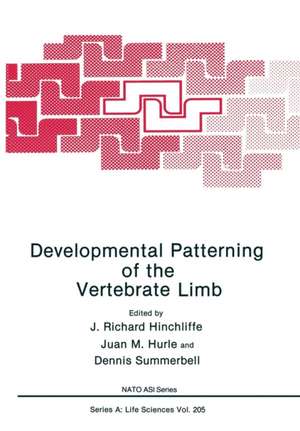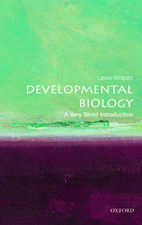Developmental Patterning of the Vertebrate Limb: NATO Science Series A:, cartea 205
Editat de J. Richard Hinchliffe, Juan M. Hurle, Dennis Summerbellen Limba Engleză Paperback – 29 oct 2012
Din seria NATO Science Series A:
- 15%
 Preț: 656.58 lei
Preț: 656.58 lei - 15%
 Preț: 655.13 lei
Preț: 655.13 lei - 15%
 Preț: 678.35 lei
Preț: 678.35 lei -
 Preț: 397.38 lei
Preț: 397.38 lei - 5%
 Preț: 377.87 lei
Preț: 377.87 lei -
 Preț: 397.76 lei
Preț: 397.76 lei - 18%
 Preț: 1232.41 lei
Preț: 1232.41 lei - 5%
 Preț: 731.64 lei
Preț: 731.64 lei -
 Preț: 413.15 lei
Preț: 413.15 lei - 15%
 Preț: 649.22 lei
Preț: 649.22 lei - 5%
 Preț: 369.45 lei
Preț: 369.45 lei -
 Preț: 407.56 lei
Preț: 407.56 lei - 5%
 Preț: 2162.19 lei
Preț: 2162.19 lei -
 Preț: 407.39 lei
Preț: 407.39 lei -
 Preț: 396.40 lei
Preț: 396.40 lei - 15%
 Preț: 663.93 lei
Preț: 663.93 lei -
 Preț: 387.38 lei
Preț: 387.38 lei -
 Preț: 393.13 lei
Preț: 393.13 lei -
 Preț: 398.35 lei
Preț: 398.35 lei -
 Preț: 401.24 lei
Preț: 401.24 lei - 15%
 Preț: 678.81 lei
Preț: 678.81 lei -
 Preț: 395.09 lei
Preț: 395.09 lei - 18%
 Preț: 952.40 lei
Preț: 952.40 lei - 15%
 Preț: 654.43 lei
Preț: 654.43 lei -
 Preț: 402.00 lei
Preț: 402.00 lei -
 Preț: 401.24 lei
Preț: 401.24 lei - 15%
 Preț: 655.27 lei
Preț: 655.27 lei -
 Preț: 394.71 lei
Preț: 394.71 lei -
 Preț: 384.48 lei
Preț: 384.48 lei - 5%
 Preț: 395.61 lei
Preț: 395.61 lei - 5%
 Preț: 1421.57 lei
Preț: 1421.57 lei - 15%
 Preț: 651.34 lei
Preț: 651.34 lei -
 Preț: 400.10 lei
Preț: 400.10 lei -
 Preț: 386.99 lei
Preț: 386.99 lei - 5%
 Preț: 386.11 lei
Preț: 386.11 lei -
 Preț: 403.91 lei
Preț: 403.91 lei - 15%
 Preț: 651.51 lei
Preț: 651.51 lei -
 Preț: 393.90 lei
Preț: 393.90 lei - 5%
 Preț: 376.43 lei
Preț: 376.43 lei -
 Preț: 400.26 lei
Preț: 400.26 lei - 5%
 Preț: 388.84 lei
Preț: 388.84 lei -
 Preț: 400.65 lei
Preț: 400.65 lei - 5%
 Preț: 740.58 lei
Preț: 740.58 lei - 18%
 Preț: 1225.16 lei
Preț: 1225.16 lei - 5%
 Preț: 386.46 lei
Preț: 386.46 lei -
 Preț: 421.82 lei
Preț: 421.82 lei
Preț: 401.79 lei
Nou
Puncte Express: 603
Preț estimativ în valută:
76.88€ • 80.49$ • 63.62£
76.88€ • 80.49$ • 63.62£
Carte tipărită la comandă
Livrare economică 05-19 aprilie
Preluare comenzi: 021 569.72.76
Specificații
ISBN-13: 9781461364573
ISBN-10: 1461364574
Pagini: 468
Ilustrații: XI, 452 p.
Greutate: 0.74 kg
Ediția:1991
Editura: Springer Us
Colecția Springer
Seria NATO Science Series A:
Locul publicării:New York, NY, United States
ISBN-10: 1461364574
Pagini: 468
Ilustrații: XI, 452 p.
Greutate: 0.74 kg
Ediția:1991
Editura: Springer Us
Colecția Springer
Seria NATO Science Series A:
Locul publicării:New York, NY, United States
Public țintă
ResearchCuprins
Some Problems in Limb Development.- The Molecular Basis of Limb Patterning: A Review.- Expression of the Msh-like Homeobox-containing Genes During Mouse Limb Development.- The Limb Deformity Gene Encodes Evolutionarily Highly Conserved Proteins.- The Role of Homeobox Genes in Amphibian Limb Development and Regeneration.- Homeobox-Containing Genes and Gap Junctional Communication in Pattern Formation During Chick Limb Development.- Functional Studies of Genes in the Limb.- Hox-7: Temporal Patterns of Expression in Normal and Limbless Chick Embryos.- Expression Profile of Two Homeobox Genes During Chicken Embryogenesis.- Characterisation of Three Zebrafish Genes Related to Hox-7.- A Comparison of the Expression Domains of the Murine Hox-4, RARs and CRABP Genes Suggest Possible Functional Relationships During Patterning of the Vertebrate Limb.- Retinoic Acid Nuclear Receptors.- The Role of Retinoic Acid and Cellular Retinoic Acid-Binding Protein in the Regenerating Amphibian Limb.- Retinoic Acid Treatment Alters the Pattern of Retinoic Acid Receptor Beta Expression in the Embryonic Chick Limb.- Expression Pattern of an RXR Nuclear Receptor Gene in the Chick Embryo.- Retinoic Acid and Limb Pattern Formation in Cell Culture.- Growth Factors Produced by the Polarising Zone - a Complement to the Retinoic Acid System.- Biochemical and Molecular Aspects of Retinoid Action in Limb Pattern Formation.- Position-Dependent Properties of Limb Cells.- Retinoic Acid and Limb Patterning and Morphogenesis.- Does Retinoic Acid Organise a Limb or Induce a ZPA?.- Retinoic Acid Effects on Experimental Chick Wing Buds: Patterns of Cell Death and Skeletogenesis.- A Comparison of Reaction Diffusion and Mechanochemical Models for Limb Development.- The Pathway of Polarising Activity fromHensen’s Node to the Wing Bud in the Chick Embryo.- Extracellular Matrix in Early Limb Development.- Molecular Heterogeneity of Chondroitin Sulphate in the Developing Chick Limb.- Special Properties of the AER/Mesenchyme Interface in the Chick Wing Bud: Analysis of ECM Molecules and Integrin Receptors.- Physical Forces and Pattern Formation in Limb Development.- Extracellular Material Organization and Long Tendon Formation in the Chick Leg Autopodium. In Vivo and In Vitro Study.- Hyaluronan-Cell Interactions in Limb Development.- The Role of the Transforming Growth Factor-ß (TGF-ß) Family, Extracelluiar Matrix and Gap Junctional Communication in Limb Cartilage Differentiation.- Vascular Involvement in Cartilage and Bone Development.- Patterning of Connective Tissues in the Regenerating Amphibian Limb.- The Interdigital Spaces of the Chick Leg Bud as a Model for Analysing Limb Morphogenesis and Cell Differentiation.- A “Packaging Model” of Limb Development.- The Somite-Muscle Relationship in the Avian Embryo.- Observations Concerning the Control of Directed Myogenic Cell Migration.- Extracellular Matrix and Muscle Formation.- Control of Muscle Morphogenesis and Endplate Pattern in Limb Muscles of Avian Chimeras.- Review of the Extracellular Matrix in Relation to Limb Development.- Evolution of Connective and Skeletal Tissues.- Developmental Approaches to the Problem of Transformation of Limb Structure in Evolution.- New Palaeontological Contributions to Limb Ontogeny and Phylogeny.- The Fin-Limb Transformation: Palaeontological and Embryological Evidence.- The Development of the Teleost Fin and Implications for our Understanding of Tetrapod Limb Evolution.- Phylogenetically Ancient Pattern in Ontogenesis of Limb Muscles.- Mutation and Limb Evolution.- Insightsinto Limb Development and Pattern Formation from Studies of the Limbless and Talpid2 Chick Mutants.- Proximal Elements in the Vertebrate Limb: Evolutionary and Developmental Origin of the Pectoral Girdle.- Evolutionary Transformation of Limb Pattern: Heterochrony and Secondary Fusion.- Plasticity in Skeletal Development: Knee-Joint Morphology in Fibula-Deficient Chick Embryos.- The Implications of “The Bauplan” for Development and Evolution of the Tetrapod Limb.- Molecular Biology and Evolution: Two Perspectives — A Review of Concepts.- The Developmental Basis of Limb Evolution: a Review.- Participants.







